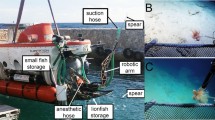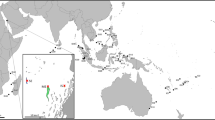Abstract
Invasion of the western Atlantic Ocean, Caribbean Sea, and Gulf of Mexico by the Indo-Pacific lionfish, Pterois volitans/miles (Scopaenidae), has caused well-documented critical changes to coral reef ecosystems throughout the region. Most efforts to quantify these changes have focused on the charismatic adult stage; much less is known about the pelagic larval stage. While dispersal by the larval stage has likely been the main contributor to the rapid population expansion throughout the region, there are very few documented cases of larvae being collected anywhere in the invaded region where adult lionfish are abundant. We compared ichthyoplankton collected using identical sampling gear from the Straits of Florida in 2007–2008 (pre-lionfish population expansion to the Florida Keys) to those collected in 2014–2015 (during the ongoing expansion), providing the opportunity to test for a temporal change in the ichthyoplankton. Despite a substantially greater sampling effort in 2007–2008 [total of 938,126 m3 of water sampled compared to approximately 144,013 m3 (~ 15%) sampled in 2014–2015], we collected no lionfish larvae in 2007–2008, whereas in 2014–2015, 76 larvae were collected. The overall mean density in 2014–2015 of 0.4–0.7 lionfish larvae 1000 m−3 is comparable to a number of common reef fish families and is likely beginning to have an ecological impact on plankton constituents. As the invasion continues, additional studies of the ecological role of lionfish larvae in the plankton are warranted.

Photo credit: Cedric Guigand, University of Miami

Similar content being viewed by others
References
Albins MA, Hixon MA (2013) Worst case scenario: potential long-term effects of invasive predatory lionfish (Pterois volitans) on Atlantic and Caribbean coral-reef communities. Environ Biol Fish 96:1151–1157
Behrenfeld MJ (2014) Climate-mediated dance of the plankton. Nat Clim Change 4:880–887
Betancur-R R, Hines A, Acero PA, Orti G, Wilbur AE, Freshwater DW (2011) Reconstructing the lionfish invasion: insights into Greater Caribbean biogeography. J Biogeogr 38:1281–1293
Côté IM, Smith NS (2018) The lionfish Pterois sp. invasion: has the worst-case scenario come to pass? J Fish Biol 92:660–689
Cowen RK, Gawarkiewicz G, Pineda J, Thorrold SR, Werner FE (2007) Population connectivity in marine systems: an overview. Oceanography 20:14–21
Cury PM, Shin Y-J, Planque B, Durant JM, Fromentin J-M, Kramer-Schadt S, Stenseth NC, Travers M, Grimm V (2008) Ecosystem oceanography for global change in fisheries. Trends Ecol Evol 23:338–346
Field CB, Behrenfeld MJ, Randerson JT, Falkowski PG (1998) Primary production of the biosphere: integrating terrestrial and oceanic components. Science 281:237–240
Green SJ, Akins JL, Maljkovic A, Côté IM (2012) Invasive lionfish drive Atlantic coral reef declines. PLoS ONE 7:e32596
Green SJ, Dulvy NK, Brooks AM, Akins JL, Cooper AB, Miller S, Côté IM (2014) Linking removal targets to the ecological effects of invaders: a predictive model and field test. Ecol Appl 24:1311–1322
Huebert KB, Sponaugle S, Cowen RK (2010) Predicting the vertical distributions of reef fish larvae in the Straits of Florida from environmental factors. Can J Fish Aquatic Sci 67:1755–1767
Kitchens LL, Paris CB, Vaz AA, Ditty JG, Cornic M, Cowan JH Jr, Rooker JR (2017) Occurrence of invasive lionfish (Pterois volitans) larvae in the northern Gulf of Mexico: characterization of dispersal pathways and spawning areas. Biol Invasions 19:1971–1979
Kulbicki M, Beets J, Chabanet P, Cure K, Darling E, Floeter SR, Galzin R, Green A, Harmelin-Vivien M, Hixon M, Letourneur Y, Lison de Loma T, McClanahan T, McIlwain J, MouTham G, Myers R, O’Leary JK, Planes S, Vigliola L, Wantiez L (2012) Distributions of Indo-Pacific lionfishes Pterois spp. in their native ranges: implications for the Atlantic invasion. Mar Ecol Progr Ser 446:189–205
Llopiz JK, Cowen RK (2009) Variability in the trophic role of larval coral reef fishes in the oceanic plankton. Mar Ecol Prog Ser 381:259–272
Llopiz JK, Richardson DE, Shiroza A, Smith SL, Cowen RK (2010) Distinctions in the diets and distributions of larval tunas and the important role of appendicularians. Limnol Oceanogr 55:983–996
Morris JA Jr, Atkins JL (2009) Feeding ecology of invasive lionfish (Pterois volitans) in the Bahamian archipelago. Environ Biol Fish 86:389–398
Morris JA Jr, Shertzer KW, Rice JA (2011) A stage-based matrix population model of invasive lionfish with implications for control. Biol Invasions 13:7–12
Richards WJ (2005) Early stages of Atlantic fishes: an identification guide for the Western Central North Atlantic, vol 1. Taylor and Francis, New York
Richardson DE, Llopiz JK, Guigand CM, Cowen RK (2010) Larval assemblages of large and medium sized pelagic species. Prog Oceanogr 86:8–20
Ruttenberg BI, Schofield PJ, Akins JL, Acosta A, Feeley MW, Blondeau J, Smith SG, Ault JS (2012) Rapid invasion of Indo-Pacific lionfishes (Pterois volitans and Pterois miles) in the Florida Keys, USA: evidence for multiple pre-and post-invasion data sets. Bull Mar Sci 88:1051–1059
Shulzitski K, Sponaugle S, Hauff M, Walter K, D’Alessandro E, Cowen RK (2018) Patterns in larval reef fish distributions and assemblages with implications for local retention in mesoscale eddies. Can J Fish Aquat Sci 75:180–192
Sponaugle S, Cowen RK (2019) Coral ecosystem connectivity between Pulley Ridge and the Florida Keys. In: Loya Y et al (eds) Mesophotic coral ecosystems, Coral Reefs of the World, vol 12. Springer, Cham, pp 897–907. https://doi.org/10.1007/978-3-319-92735-0_46
Usseglio P, Selwyn JD, Downey-Wall AM, Hogan JD (2017) Effectiveness of removals of the invasive lionfish: how many dives are needed to deplete a reef? PeerJ 5:e3043
Vasquez-Yeomans L, Carrillo L, Morales S, Malca E, Morris JA Jr, Shultz T, Lamkin JT (2011) First larval record of Pterois volitans (Pisces: Scorpaenidae) collected from the ichthyoplankton in the Atlantic. Biol Invas 13:2635–2640
Acknowledgements
We thank the scientific party and R/V Walton Smith crew for their contributions to the field sampling. We are particularly grateful to Cedric Guigand who participated in the cruises and took the photo of the live lionfish larva collected in 2015. We thank the many lab assistants and volunteers who helped with sample collection and processing over the years as well as expert advice on larval fish identification from Joel Llopiz. We are indebted to Peter Konstantinidis at Oregon State University and Emma Jugovich and Estrella Malca at NOAA’s Southeast Fisheries Science Center for assistance in confirming the identification of lionfish larvae. National Science Foundation (NSF) OCE Grant 0550732 supported the collection and processing of the 2007–2008 samples, and NSF OCE Grant 1419987 supported the 2014–2015 study. Raw collection data are available at www.bco-dmo.org/dataset/661268.
Author information
Authors and Affiliations
Corresponding author
Additional information
Publisher's Note
Springer Nature remains neutral with regard to jurisdictional claims in published maps and institutional affiliations.
Rights and permissions
About this article
Cite this article
Sponaugle, S., Gleiber, M.R., Shulzitski, K. et al. There’s a new kid in town: lionfish invasion of the plankton. Biol Invasions 21, 3013–3018 (2019). https://doi.org/10.1007/s10530-019-02070-1
Received:
Accepted:
Published:
Issue Date:
DOI: https://doi.org/10.1007/s10530-019-02070-1




